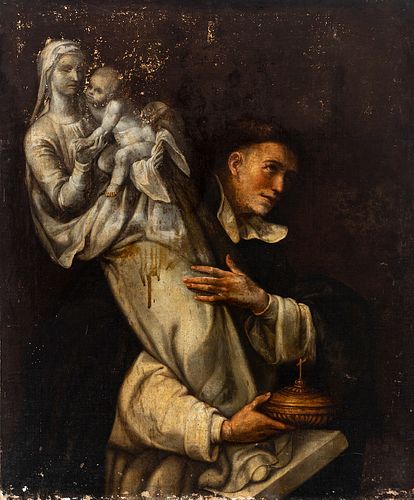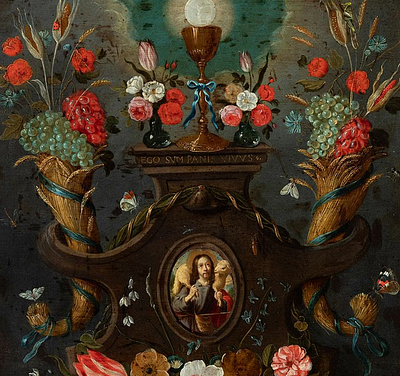Spanish school; second half of the 17th century. "Saint Hyacinth of Poland". Oil on canvas. Relined.
Lot 50
About Seller
Setdart Auction House
Carrer Aragó 346
Barcelona
Spain
Setdart Subastas was born in 2004 and is currently the first online art auction in Spain with solidity, prestige and reliability guaranteed by our more than 60,000 users. Setdart has a young, dynamic and enterprising team ready to successfully manage the purchase and sale of art works through custom...Read more
Estimate:
EUR€2,000 - EUR€2,500
$2,083.33 - $2,604.17
Absentee vs Live bid
Two ways to bid:
- Leave a max absentee bid and the platform will bid on your behalf up to your maximum bid during the live auction.
- Bid live during the auction and your bids will be submitted real-time to the auctioneer.
Bid Increments
| Price | Bid Increment |
|---|---|
| EUR€0 | EUR€10 |
| EUR€200 | EUR€25 |
| EUR€500 | EUR€50 |
| EUR€1,000 | EUR€100 |
| EUR€3,000 | EUR€200 |
| EUR€5,000 | EUR€500 |
| EUR€10,000 | EUR€1,000 |
| EUR€20,000 | EUR€2,000 |
| EUR€50,000 | EUR€5,000 |
About Auction
By Setdart Auction House
Sep 21, 2021
Set Reminder
2021-09-21 10:00:00
2021-09-21 10:00:00
America/New_York
Bidsquare
Bidsquare : 21st September - ARAS JÁUREGUI Private Collection - Old Masters, 19th & 20th Century
https://www.bidsquare.com/auctions/setdart-auction-house/21st-september---aras-j-uregui-private-collection---old-masters-19th-20th-century-7429
Setdart Auction House sofia@setdart.com
Setdart Auction House sofia@setdart.com
- Lot Description
Spanish school; second half of the 17th century. "Saint Hyacinth of Poland". Oil on canvas. Relined. It presents faults, repainting and new areas of stucco. Measurements: 121 x 99 cm. Saint Hyacinth of Poland was a Polish Dominican priest and missionary who worked to reform the monasteries of women in his native Poland. He was a Doctor of Sacred Studies, educated in Paris and Bologna. Called the "Apostle of the North", while in Rome, he witnessed a miracle performed by Dominic of Osma and became a Dominican friar. In 1219, Pope Honorius III invited Dominic and his followers to settle in the ancient Roman basilica of Santa Sabina, which they did in early 1220. Tradition holds that he evangelised in Sweden, Norway, Denmark, Prussia, Scotland, Russia, Turkey and Greece. One of the greatest miracles attributed to Hyacinth occurred during a Mongol attack on Kiev. As the friars were preparing to flee from the invading forces, Hyacinth went to save the ciborium containing the Blessed Sacrament from the tabernacle of the monastery chapel, when he heard the voice of Mary, the mother of Jesus, asking him to take it too. Hyacinth picked up the large stone statue of Mary, as well as the ciborium. He was easily able to carry both, despite the fact that the statue weighed much more than he could normally lift. Thus he saved them both. For this reason, he is usually shown holding a monstrance and a statue of Mary. The work is reminiscent of the painting of Vicente Carducho, who was a painter and treatise writer of Italian origin, although his artistic activity took place in Spain, specifically in the Madrid school. He was trained as a painter of frescoes and altarpieces, in which he reflected his language halfway between classicism and post-Renaissance mannerism. His first major work, the Preaching of Saint John the Baptist for the Monastery of San Francisco in Madrid, was considered a very daring piece for the time, a fact that indicates Carducho's importance in the complex history of art. Following the death of his brother Bartolomé Carducho, court painter to Philip II in Spain, Vicente was commissioned to decorate one of the galleries of the Royal Palace of El Pardo, where he painted the works depicting the exploits of Achilles.
- Shipping Info
-
In-house shipping available. Please inquire at admin@setdart.com.
-
- Buyer's Premium



 EUR
EUR CAD
CAD AUD
AUD GBP
GBP MXN
MXN HKD
HKD CNY
CNY MYR
MYR SEK
SEK SGD
SGD CHF
CHF THB
THB

















